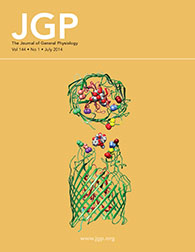Protein's "hands" enable bacteria to establish infection, research finds
Tuesday, July 15, 2014
MANHATTAN — When it comes to infecting humans and animals, bacteria need a helping hand.
Kansas State University biochemists have found the helping hand: groups of tiny protein loops on the surface of cells. These loops are similar to the fingers of a hand, and by observing seven individual loops on the surface of E. coli bacterial cells, the researchers found that the loops can open or close to grab iron in the environment.
"These structures are like small hands on the surface of bacterial cells," said Phillip Klebba, principal investigator and professor and head of biochemistry and molecular biophysics. "They make the bacteria capable of recognizing something and grabbing it from the environment. It's amazing that such a tiny molecule can do that."
Kansas State University researchers are the first to observe this process. Their experiments may lead to new ways to protect people and animals against bacterial infections by helping scientists develop targeted treatment and intervention methods.
The research is featured as the cover article for the July issue of the Journal of General Physiology.
All cells need iron to stay alive, which puts iron at the center of the microbial pathogenesis process. When bacteria invade an animal or human, they must acquire iron to establish an infection, Klebba said.
"A microbiological war is going on in the host tissue," Klebba said. "The host is trying to prevent the microbe from getting iron. The microbe is trying to get the iron using proteins that can essentially see their environment, grab iron and internalize it into the bacterial cell."
In the latest research, the scientists used site-directed spectroscopic analysis of E. coli cells to monitor the activity of the surface transport proteins. Through their experiments, they observed the seven loops on the cell surface moving as they recognized and absorbed iron in the environment for later transport into the cell.
The absorption process happens quickly and efficiently, Klebba said. Less than a second after the bacteria enter an environment with iron compounds, they recognize the molecules, grab them and start the transfer process.
"If we can understand exactly how this acquisition process works, we can design, isolate or identify small molecules that inhibit the iron uptake process," Klebba said. "Those are potentially antimicrobial agents that could protect people and animals against bacterial disease."
The scientists will continue the research to get a full understanding of how the proteins manage to transport iron from the outside to the inside of cells.
The research received support from the National Institutes of Health and the National Science Foundation. Research collaborators from Kansas State University include: Salete M.C. Newton, research professor of biochemistry and molecular biophysics; Mathew Hanson, master's student in biochemistry, Hays; Lorne Jordan, doctoral student in biochemistry, Toledo, Ohio; Yan Shipelskiy, doctoral student in biochemistry, Holland, Pennsylvania; and Aritri Majumdar, doctoral student in biochemistry, Kolkata, India.
Collaborators from the University of Oklahoma's department of chemistry and biochemistry include Chuck R. Smallwood, Vy Trinh, Daniel W. Schuerch and Amparo Gala.

